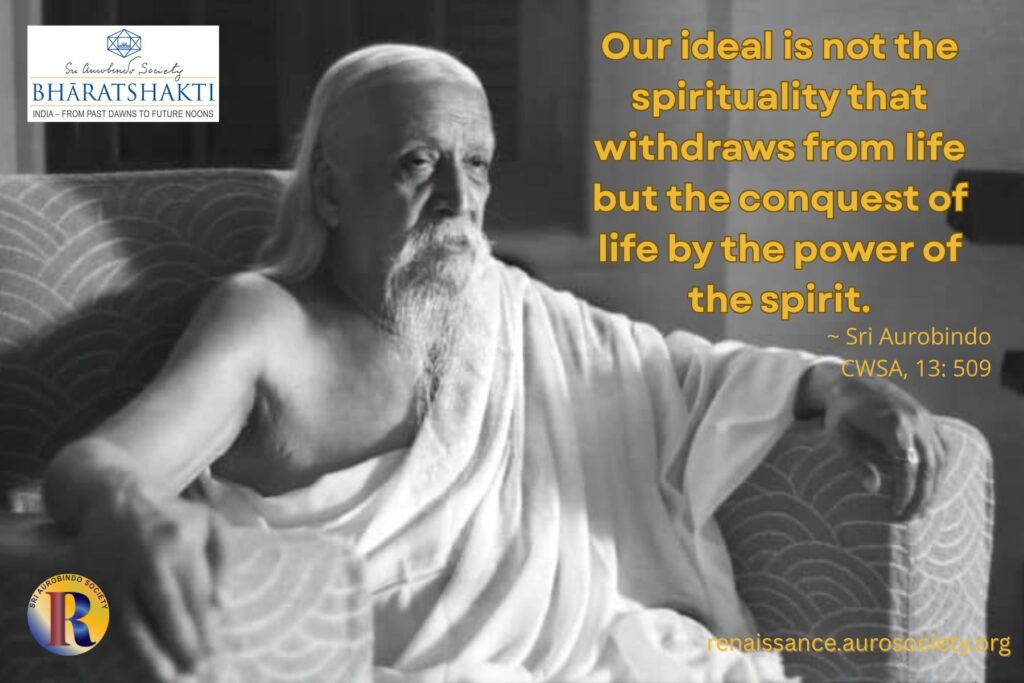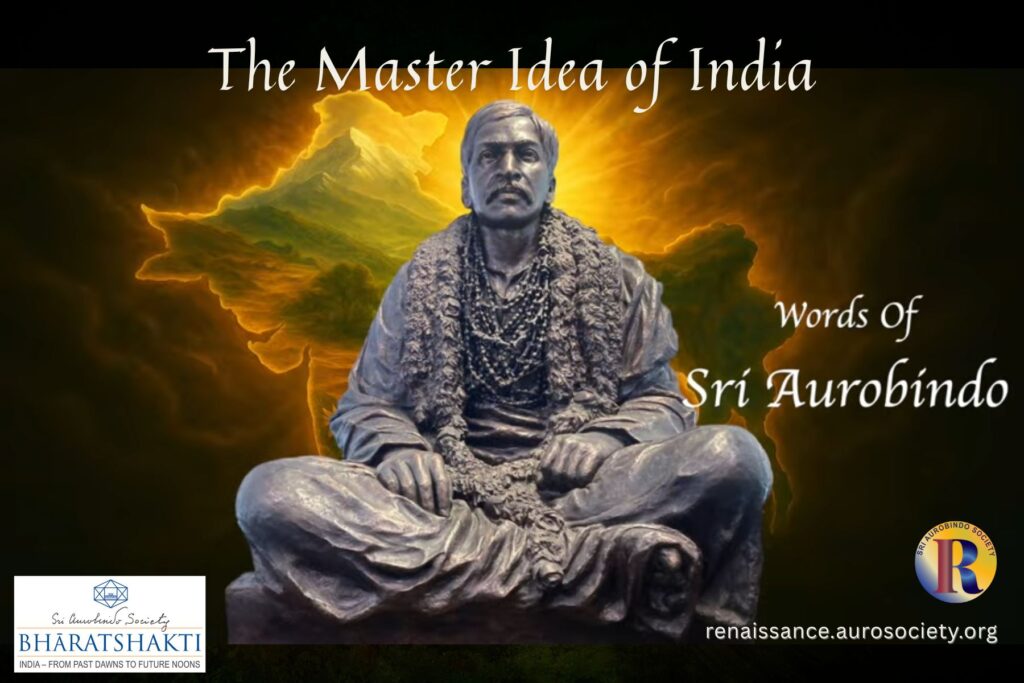Volume III, Issue 3
Author: Shruti Bidwaikar
Editor’s note: Sri Aurobindo’s poem Baji Prabhou is inspired by the well-known historical event when Baji Prabhou Deshpande, to cover Shivaji Maharaj’s retreat, held the fort of Rangana for over two hours with a small company of men against twelve thousand Mughal soldiers. In this close study of the poem, Shruti Bidwaikar examines how the poet expresses the exemplary strength, patriotism and valour of Baji Prabhou through the beauty of different rasa-s. But the pen of the seer-poet Sri Aurobindo has also infused the poem with a deeper spiritual philosophy and ideal, which gives it a powerful intensity and leaves a strong impact on the reader.
This essay was first published in the August 2015 issue of New Race: A Journal of Integral Studies. We are happy to republish it here with the author’s and publisher’s permission. For this digital presentation, we present it in two parts. A few minor edits have been made by the editors.

PART 1
Baji Prabhou was “conceived and written in Bengal during the period of political activity” wrote Sri Aurobindo (CWSA, Vol. 2, p. 704). K. D. Sethna in his introductory remarks in his analysis of the long poem writes:
“It is granite in its suggestion of strength and at the same time as brightly flexible and resonant as a Damascus blade. It is founded on the historical incident of the tremendous self-sacrifice of Baji Prabhou Deshpande, who to cover Shivaji’s retreat held the fort of Rangana for over two hours with a small company of men against twelve thousand Moguls”
(Sethna, Sri Aurobindo the Poet, 17)
This granite strength in the poem is not all that easy to achieve by. It is only the deft hand of the seer-poet who could translate the intensity of the patriotic fervor into rhythm. For Sri Aurobindo himself observes the difficulty:
…patriotic poetry, war poetry or poetry of the occasion and the moment are so difficult to write greatly and, although it would seem that these things are among the most dynamic and should move most easily to powerful utterance, are oftenest poor in poetic substance and inferior in value. For life they may be dynamic, but they are not so readily dynamic for art and poetry, and precisely because the vital interest, the life attraction is so strong that it is difficult to draw back from the external to the spiritual delight and the spiritual significance.
(CWSA, Vol. 26, p. 261)
This patriotic narrative has not only been able to capture the vitality of a valiant soldier but has transcended it and assimilated a deeper spiritual philosophy and ideal. It is this ideal, this “spirit” added to “life” that gives the desired intensity to the poem.
In fact, there are two main streams running parallel – one the war, chivalry, gallantry of Baji Prabhou which is intensified with images and description of the harsh nature. Second is the ideal that Shivaji, the king, has set before his countrymen: the ideal to fight for the nation with the strength of God. In its spirit it is a war poetry, vividly describing each and every move of the Mughals to defeat Shivaji. The Rajputs, Pathans etc, with their might launch successive attacks on the Maratha soldiers and the latter defend their land with equal strength. This picture is portrayed so dramatically that the reader gets arrested in its description.
Poetic Portrayal of War by Sri Aurobindo
One is led to think of the craftsmanship and command of Sri Aurobindo not only in the imagination of the war scene but also of the usage of the war vocabulary. However, the ideal is what lingers on the minds after the reading of the poem.
The practice of Bhagvad Gita which was taught to Shivaji by his spiritual mentors also seems to have influenced a few of his warriors. It is amply reflected in Baji’s attitude towards life and war.
The poem also seizes us with the warrior’s faith in Bhavani and the conviction that the Divine Mother will make them Her instruments in the war.
Therefore Baji Prabhou is not only the story of Baji alone. It speaks of Shivaji’s ideal, Baji’s patriotism, and Sri Aurobindo who like his characters in the poem has himself lived them.
The description of the weather in the opening lines of the poem would at once affect the readers for its horrendous and uninhabitable condition. See here:
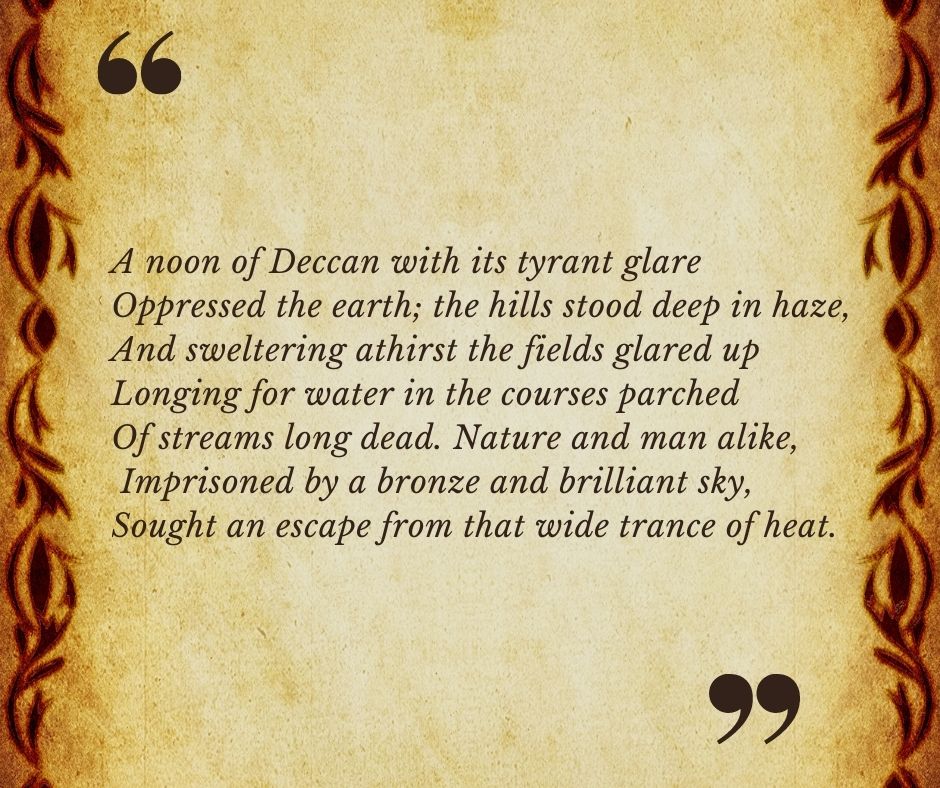
It is in this torturous state that the war would take place.
This battle at the Ghodkhind pass was fought in July 1660. During this time of the year the Sahyadri Mountains are barren. They radiate heat as they are rocky and dry. Raigad (where the Shivaji’s fort is located) being on the leeward side receives rains much later than the seaward side. Therefore, even in July the mountain range is still dry and hot.
Sri Aurobindo had lived and travelled through Maharashtra many a time. He was aware of the weather conditions of this area and would have experienced the heat of those barren mountains many times. It is with his experience that he describes the parched land, the “brilliant sun” and its “tyrant glare”.
Experientially, it is a horrifying but poetically it befits the demand of the poem. In one of his letters, addressing the use of the horrendous and ugly as the material of poem Sri Aurobindo wrote:
“. . . a thing that is ugly becomes beautiful by its fitness for expressing the significance, the guna, the rasa which it was meant to embody”
(CWSA, Vol. 27, p. 702)
This poem too successfully uses the horrors of war and weather to create the bhayanaka (horror) rasa.
In fact there are a few rasas that mark the poem – bhayanak, raudra (chivalrous), adbhuta (surprise/ wonder), karuna (compassion) and shanta (peace). The bhayanak and adbhuta are almost interwoven, whereas veera and raudra strike us wherever Baji comes into the scene. Karuna and shanta rasas are evoked when Shivaji’s unsaid feelings for his Motherland and Baji Prabhou call for a silent tribute.
Also Read:
Of Courage, Wars, and Evolution of the Earth
Bhayanaka and adbhuta
Usually adbhuta by its very use in poetry is likely to arouse a pleasant surprise. But if we go by larger connotation of the word, we realise that all that is unknown, unexpected and makes our brows rise or hearts sink is indeed adbhuta, surprising from the poetic viewpoint.
In this poem a horrifying description is always coupled with a surprising imagery. We may cite examples which present both these rasa-s quite effectively and they are almost always mutually inclusive. Phrases like “noon of Deccan”, “tyrant glare”, “longing for water”, “Imprisoned by a bronze and brilliant sky”, “slaying heat” immediately bring to us the horrors of the weather that we mentioned above.
Here “brilliant” may have been used to give the effect of both the torturous and the marvellous. The term “bronze” at once reminds of the “copper sky” described by Coleridge in The Rime of Ancient Mariner which describes the terrifying conditions of the still sea. Both the terms “brilliant” and “bronze” heighten the impact of the heat making it unbearable and unimaginable.
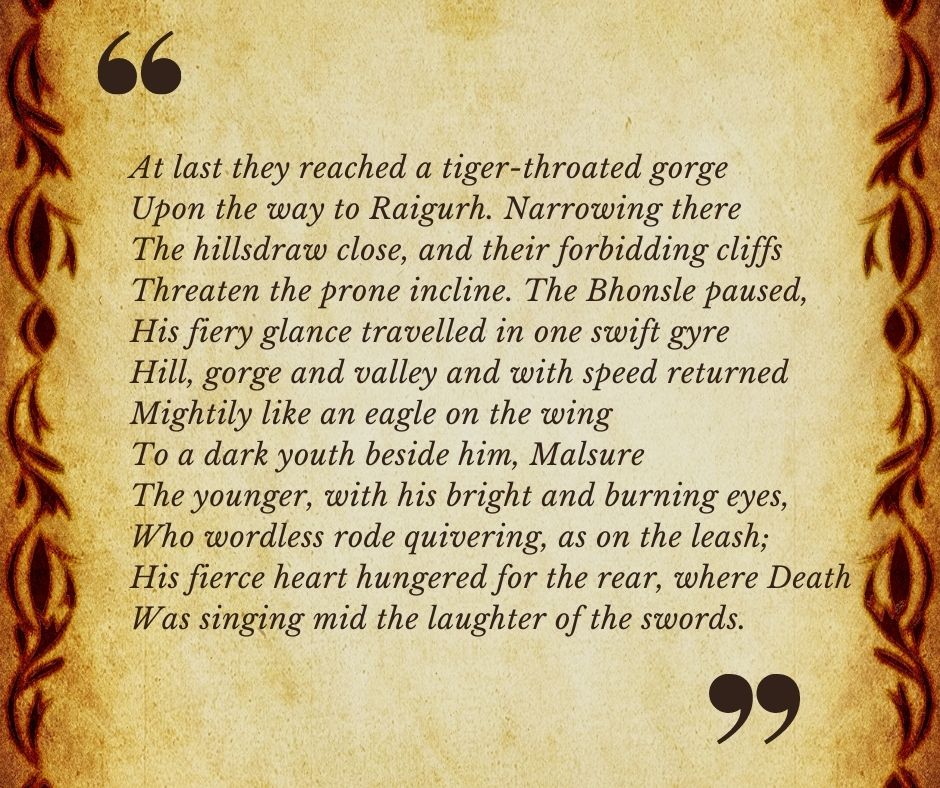
These lines again call our attention to the horror of the terrain and make us wonder at the faculties of war of Shivaji and Baji. Shivaji himself explains the horror of this “tiger-throated gorge” thus:
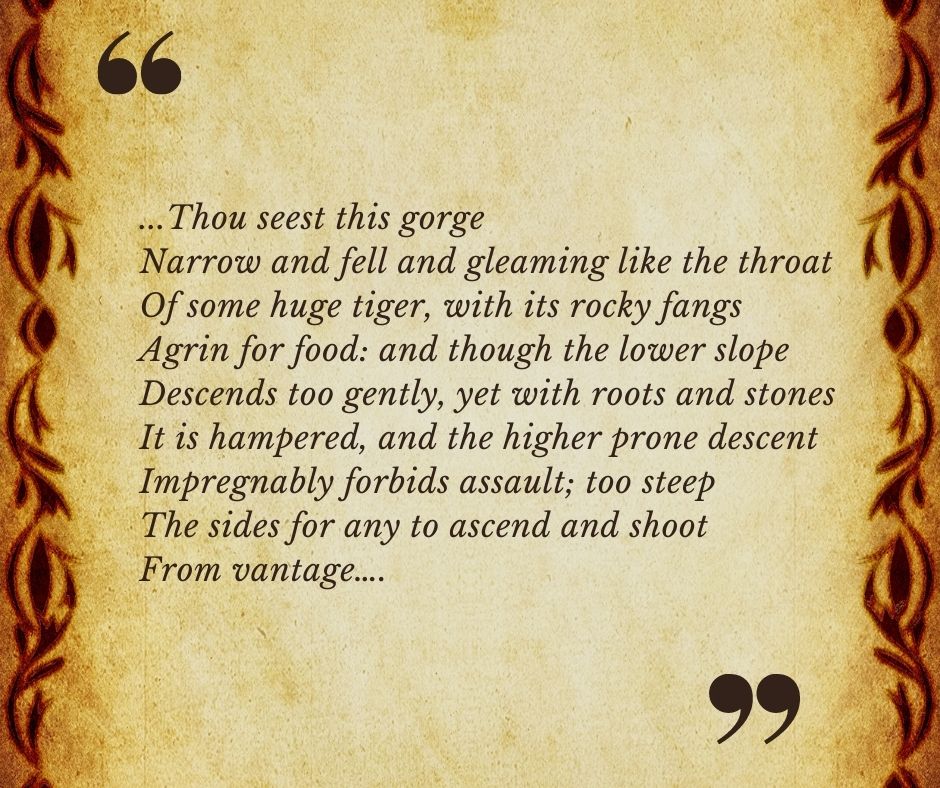
The horrors of a jungle are synonymous with the roar of the tiger. A tiger invokes mortal fear and at the same time one is in awe of this ferocious but beautiful animal. The description of the gorge as being “tiger-throated” speaks much more than just the geographical make-up of the place. The poet has used it purposely to arouse fear and wonder.
To describe the immensity of the destructive force of Baji’s wrath, Sri Aurobindo uses the image of the destructive waves.
Ever foremost where men fought,
Was Baji Prabhou seen, like a wild wave
Of onset or a cliff against the surge.
Then
Towards him singling out the lofty crest,
The princely form: and, as the waves divide
Before a driving keel, the battle so
Before him parted, till he neared, he slew.
The tidal waves are again those wonderful phenomena of nature which invoke beauty and terror at once. It is always beautiful to see a rising wave but its rise is directly proportional to its destructive capacity. It almost appears like the beauty that destroys. Watch a warrior like Baji Prabhou fight would be instantly awe-inspiring but also as horrifying as a wave — like a “wild-wave” engulfing his enemies.
Interestingly, Sri Aurobindo has used waves, sea, river and clouds in different forms to create an atmosphere and magnify the intensity of war.
These images quite prominently recur throughout the poem. For instance, “still the sea/ Of men bore onward” and “till like a bank/ Of some wild river the assault collapsed”, and yet again the nature of Baji’s slaying “as a knife cuts instantly its way/Through water” — with such an ease the men were put to death.
Active they thronged
Humming like bees and stung strong lives to death
Making a holiday of carnage.
Here is another image: the attack of the humming bees which one cannot escape. Such was the attack by the Maratha Battalion. They swarmed like the bees whose combs are struck by a stone and their house endangered. Another phrase “holiday of carnage” evokes horror to the marrow. It is intriguing and poetically pleasing to read this phrase, for it is paradoxical.
Paradox however, evokes the widest imagination possible and that is the reason Isha Upanishad is so very intriguing, interesting and yet gripping. For it is through paradoxes that the idea is suggested.
The idea of holiday is suggestive of something more relaxing, soothing and a day when one follows one’s hobbies at which one is interested; but a hobby of slaughter! It also suggests the deftness of the warriors. Like the bees skilled at protecting their home and following one’s hobbies on a holiday, the soldiers are trained in protecting their land. Therefore, this slaughter has the deftness as well the interest of the warriors to save their motherland.
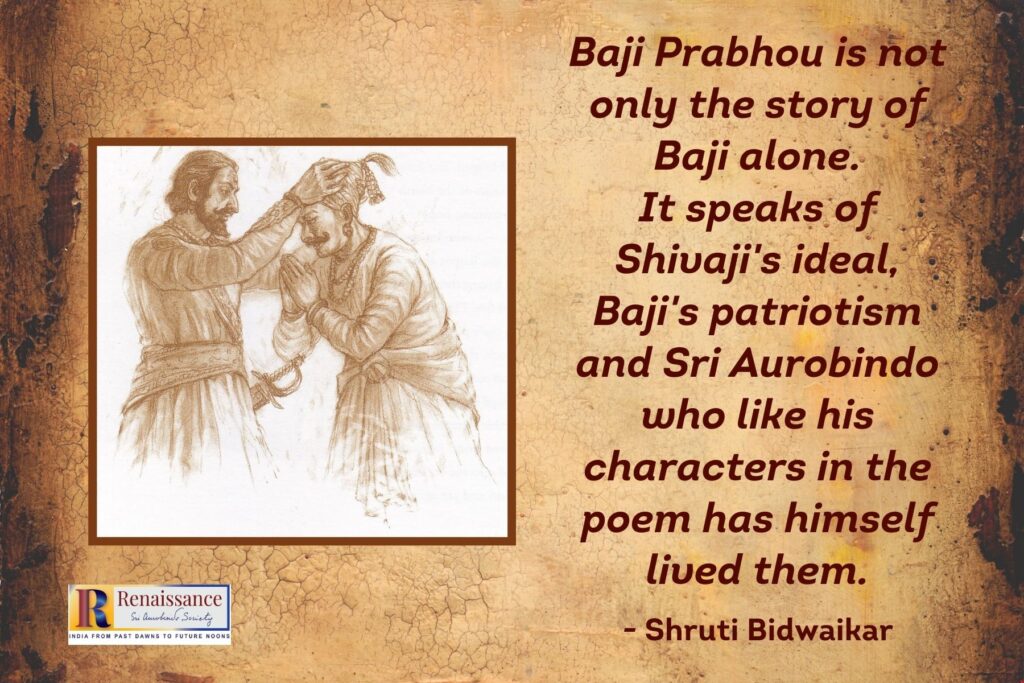
It is not only through the help of nature that Sri Aurobindo evokes horror and wonder but also by the live description of death in the war. Here is an example,
They came, they died; still on the previous dead
New dead fell thickening. Yet by paces slow
The lines advanced with labour infinite
And merciless expense of valiant men.
For even as the slopes were filled and held,
Still the velocity and lethal range
Increased of the Mahratta bullets; dead
Rather than living held the conquered slope,—
The living who, half-broken, paused.
And
…there for a while
A slaughter grim went on and all the verge
Was heaped and walled and thickly fortified
With splendid bodies.
Similarly, when Baji is wounded,
By his side fell fast
Mahratta and Mogul and on his limbs
The swords drank blood, a single redness grew
His body, yet he fought. Then at his side
Ghastly with wounds and in his fiery eyes
Death…
These lines speak of the chivalry of Baji and his battalion and the death scenes of the war. A close reading of the poem gives instances of many more lines of such horrific description.
Sri Aurobindo’s poetry itself is a source of amazement and joy.
One such pleasant discovery in the poem is the way Sri Aurobindo gives us the sense of time. The time from when Shivaji realizes the necessity of the war in the gorge because of the Mughal advances and the time at which the war starts and ends are all wonderfully suggested just by the position of sun.
Dawn,
At morning when the sun
Was yet below the verge, the Bhonsle sprang
At a high mountain fortress…
Afternoon,
…then where the sun in fire
Descending stooped
Dusk,
And from time to time the gaze
Of Baji sought the ever-sinking sun.
Evening,
But when the sun dipped very low, a stir
Was felt far off
Night,
Bright in the glory of the sinking sun
A jewelled aigrette blazed.
Only a poet with a great craftsmanship will suggest the time by the position of the sun and not by the setting darkness.
Similarly, the rapidity and speed of lines and the placement of words which K.D. Sethna has discussed in detail arouse a sense of wonder for the poet that Sri Aurobindo is.
Also See:
Sri Aurobindo on Courage and Nationalism
Shanta and Karuna
There are many instances in the poem that speak of the expectant silence before the lethal storms rage in. It surely creates peace, but peace which is rather disturbing than soothing. However, here are a few examples in which the silence is expansive and deepening. It does not make one restless but speaks volumes about Shivaji’s character. In fact this character is also reflected by the Nature.
And the Chief
With a high calmness in his shining look,
“We part, O friend, but meet again we must,
When from our tasks released we both shall run
Like children to our Mother’s clasp.”
Baji and his Mahrattas sole remained
Watched by the mountains in the silent gorge.
In these lines the silent strength of Shivaji is as if transferred to the mountains and they remain the silent witness of the strength and sacrifice of Baji and his men.
In the end, when Baji lay dead, Shivaji is once again quiet, his heart full of gratitude and compassion and pride for his great friend and child of the motherland, Baji whose corpse speaks the story of his bravery and the dead bodies in the gorge narrate his efforts to save his motherland.
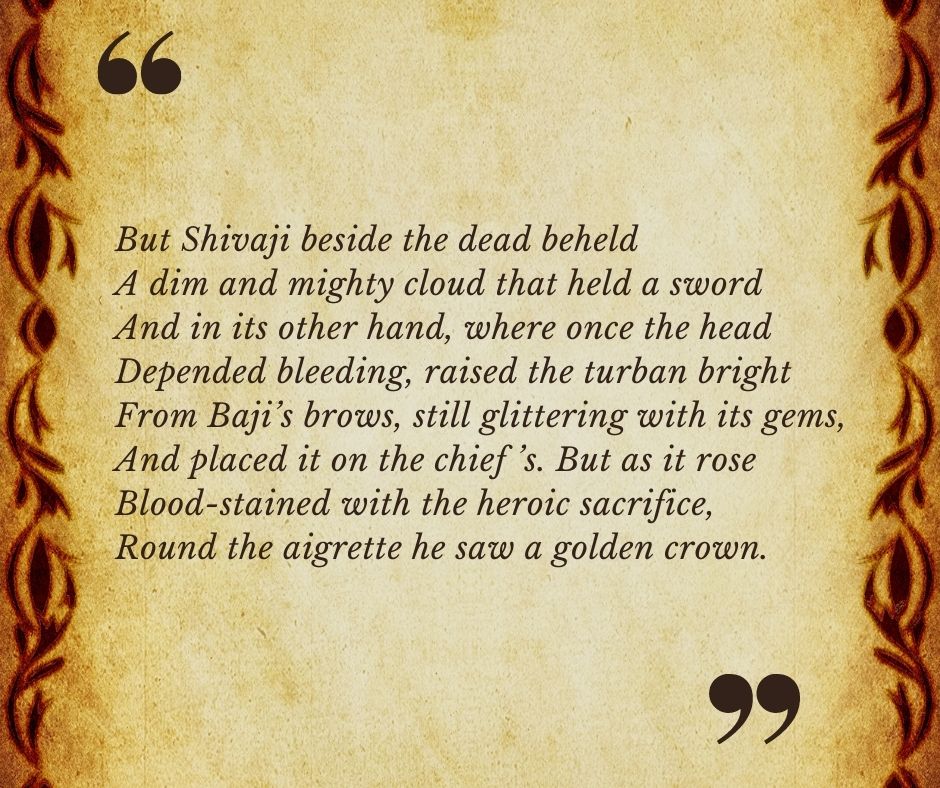
This sight surely evokes compassion. It makes one feel sorry to see all the menace there. But at the same time as is given in the lines the peace of having saved the motherland is effectively evoked in them. Also, when Tanaji Malsure sees the condition of his warriors he too is full of compassion and is filled with aspiration that he too like Baji lay his life protecting the motherland. Baji’s death therefore creates peace, compassion and a sense of chivalry in all who witness.
Veera and Raudra
The very image of Baji Prabhou evokes veera rasa which indicates bravery, the warrior spirit the kshtriya-hood of the fighter. But it is not only the chivalry of Baji that gives rise to this rasa; the mood of chivalry is also invoked by the presence of the goddess who represents raudra rasa – Bhavani (Durga), the slayer of evil.
Again and again in the poem, Baji refers to the goddess or the poet describes Baji being overpowered by the force of Bhavani with which he fights the battle.
Raudra rasa is also created when the strength of Baji is compared with an ever powerful object of Nature. In fact, read one after the other, they create all the four veera, raudra, bhayanaka and adbhuta rasa-s for the reader.
So fought they for a while; then suddenly
Upon the Prabhou all the Goddess came.
Loud like a lion hungry on the hills
He shouted, and his stature seemed to increase
Striding upon the foe.
Next,
Stood visible, Titanic, scarlet-clad,
Dark as a thunder-cloud, with streaming hair
Obscuring heaven, and in her sovran grasp
The sword, the flower, the boon, the bleeding head,—Bhavani.
And then,
Groaning, once more the grim Mahratta turned
And like a bull with lowered horns that runs,
Charged the exultant foe behind.
In these lines, hungry lion, “thunder-cloud” and in the end “bull with lowered horns” are successively horrifying. Each image succeeds the other in its intensity of causing damage and its penetrating and painful impact. If we try to alter the one with the other the effect will not be as horrifying. For when read one after the other they raise the tempo of the poem and reach its peak before the climax when Baji finally falls dead.
The lines quoted above appear almost towards the end of the poem. They surely portray Baji with a great physical power charged with Bhavani’s strength.
But the strength of his mind and soul has already been presented in the poem in the beginning.
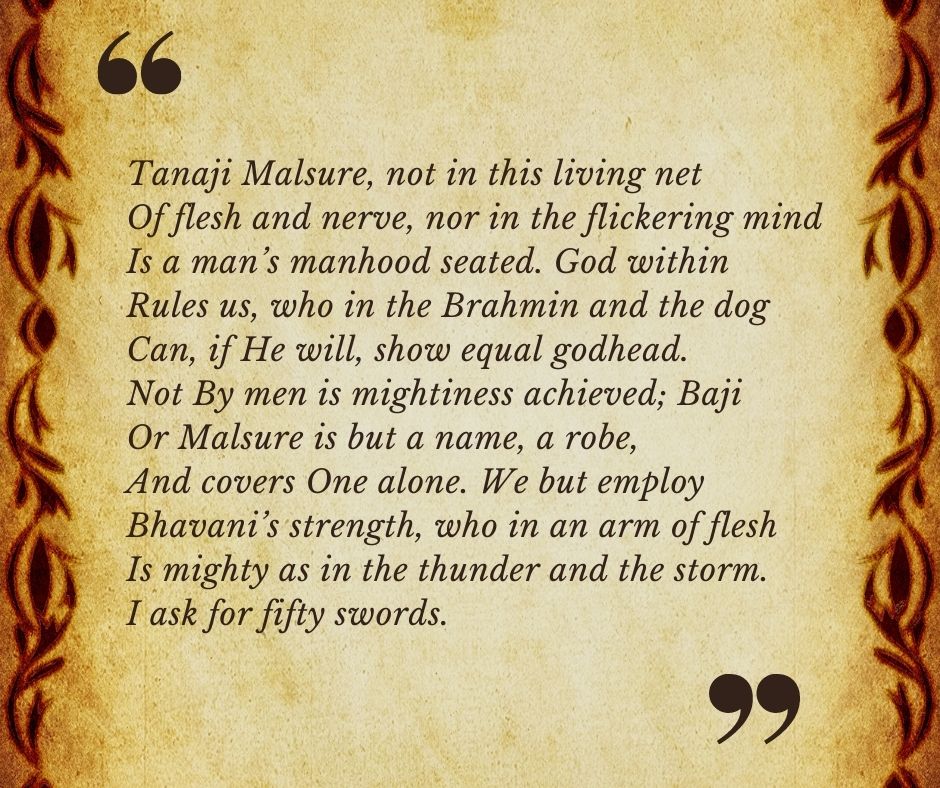
Yet again, when they had to face the enemy right in their face Baji encourages his men thus:
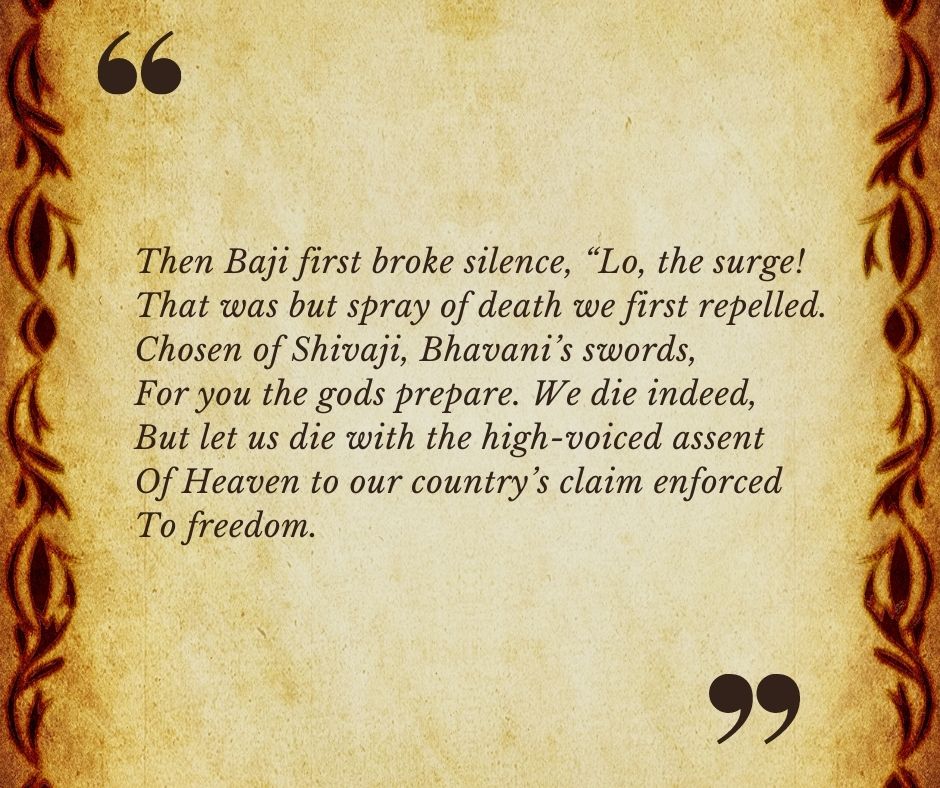
This was then the strength of his soul that Sri Aurobindo has portrayed so wonderfully. Even through his writings in Bande Mataram Sri Aurobindo hailed his people to implore the shakti of Bhavani and fight for the nation. It is exactly what Baji does.

Continue reading Part II
~ Design: Raamkumar
~ Baji Prabhou drawings by Sushanto

